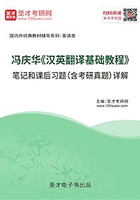
4.3 翻译示例汇总
一、动态动词的静态译法
例1:汉语动词转译为英语名词
(1)语言这个东西不是随便可以学好的,非下苦功不可。
【译文】The mastery of language is not easy and requires painstaking effort.
【解析】这句话的英译文应该说是忠实而地道的,但仔细分析一下里面的词类,却很少是对应的。原文“学好”是一个动补结构,意思相对应的英文词mastery是名词,做这样的转变是为了让译文更加通顺,更符合英语的习惯表达。当然,原文的副词“随便”在译文中也相应地转变为形容词。
(2)人口在不断地增加。
【译文】There is a steady increase in population.
【解析】我们可以看到由于动词“增加”译成了名词increase,修饰动词的副词“不断地”也相应地译成了形容词steady。
(3)交易增加,要求流通的货币量也增加。
【译文】An increase in business requires an increase in the amount of money coming into general circulation.
【解析】译文中原文的动词转译为英文中的名词,使得译文更自然、更紧凑。
(4)现在辞职就是承认失败。
【译文】To resign now would be an admission of failure.
(5)向友人借钱就是滥用友谊。
【译文】Borrowing money is an abuse of friendship.
(6)他们正在考虑释放被囚禁的那位领导人。
【译文】They are considering the release of the jailed leader.
(7)在加州发现黄金的消息轰动全国。
【译文】News of the discovery of gold in California excited the nation.
【解析】在翻译过程中,需要灵活地把汉语的动词转译为英语的名词。但一定要注意的是,在这个过程中要在名词前面添加适当的不定冠词和冠词。
(8)她教书教得好。
【译文】She is a good teacher.
(9)他喜欢流行音乐。
【译文】He is a lover of pop music.
(10)他统治那个地区长达20年之久。
【译文】He has been the ruler of the region for as long as twenty years.
【解析】汉译英时,还可以使用动词在英语中的同源名词来增加静态意味。
例2:汉语动词译为英语介词或介词短语
(1)她英语说的很棒,带着美国腔,却并不十分夸张。
【译文】She spoke English well with an American accent, not though, a very exaggerated one.
【解析】原文中“带着”在汉语里是个动词,而在译文里却以一个介词短语来对应,这样原文中分散的结构在译文中就显得非常紧凑,符合英语的表达习惯。
(2)政府支持这个项目。
【译文】The government is behind this project.
【解析】汉语“支持”为动词,而译文中却用了介词。因为介词在英语中非常活跃,汉语中的许多动词译成英语时则用含有动作意味的介词表示。
(3)这时,只见一个人,头上蒙着一个湿淋淋的口袋,从冒着熊熊烈焰的后门直冲进去。
【译文】Then a figure with a dripping-wet bag round its head dashed through the flame-filled back door.
【解析】原文中的动词“蒙着”在译文中转换成了介词短语round its head,修饰figure。这样,译文结构就显得层次分明,十分紧凑。
(4)机器在运行。
【译文】The machine is in operation.
【解析】原文中“运行”是一个动态动词,而在译文中,却用一个介词加名词的结构,把原文的动态状态完全静态了,这是英语语言的特点之一。
(5)警察在抓罪犯。
【译文】The police is in pursuit of the criminal.
【解析】原文中的“抓”是一个表动作的动态词,在译文中in pursuit of是一介词加名词的结构,使得译文总体呈现出静止的特征。
(6)他的智力超过常人。
【译文】He has intelligence beyond the ordinary.
(7)那是一幅模仿毕加索的画。
【译文】That is a picture after Picasso.
(8)然后,我感觉到冰冷的枪口顶住了我的头。
【译文】Then I felt the gun, cold, against my head.
例3:汉语动词译为英语副词
(1)我们得走了。
【译文】We must be off now.
(2)演出已经开始了。
【译文】The performance is on.
【解析】汉语中大量使用的动词,其中一部分可适当转为副词,这样一来,动作的意味就大大削弱了。
例4:汉语动词译为同源的形容词
(1)他满足于这样的生活。
【译文】He is content with such kind of life.
(2)约翰十分熟悉这台机器的性能。
【译文】John is quite familiar with the machine.
(3)并不是所有军队的人都喜欢这个计划。
【译文】This program was not popular with all of the troops.
(4)他为人能干,事业成功。
【译文】He was an able and successful one.
(5)他身体不好令人十分担忧。
【译文】His ill health has been a very anxious business.
(6)我的确不知道他们打算干什么。
【译文】I am quite ignorant of what they intend to do.
例5:汉语动词译为动名词
(1)要想知道布丁的滋味,就要亲自尝尝。
【译文】The proof of the pudding is in the eating.
(2)又要教书,又要照顾家庭,我实在忙不过来了。
【译文】My teaching and my family are proving more than enough to fill my time.
例6:
(1)1949年中国发生了翻天覆地的变化。
【译文】1949 witnessed great changes in China.
(2)5月1日会议开幕了。
【译文】May Day saw the opening of the meeting.
(3)这个运动首先在天津发起。
【译文】Tianjin first saw the rise of the movement.
(4)我没有注意到这个错误。
【译文】The mistake escaped me/my notice.
(5)我一时记不起他的名字。
【译文】His name escaped my memory for the moment.
二、静态动词的动态译法
例1:
(1)今年的十月一号是个星期五。
【译文】The National Day of this year falls on a Friday.
【解析】译文中fall是一个动态动词,给人以动作的感觉。如果采用译文的做法,就是静态动词的动态译法。此处“以静转动”,显得很符合英语的表达习惯,令人产生“恰巧”的联想。
(2)史密斯先生在上班。
【译文1】Mr. Smith is working.
【译文2】Mr. Smith is at work.
【解析】译文1中用进行时态,表示动态的概念,意为“他正在工作”,而译文2中用介词短语,表示状态,意为“他在上班的状态”。静态译法和动态译法各有千秋,但意思可能侧重不同。
(3)城南有一条河。
【译文】To the south of the city lies a river.
【解析】英文动态句式极富修辞效果,常见于景物描写。此时,在汉译英过程中,静态句式译成动态句式往往修辞效果比较好。
(4)看来我们的发展,总是要在某一个阶段,抓住时机,加速搞几年,发现问题及时加以治理,尔后继续前进。(《邓小平文选》)
【译文1】It seems that we should hold on to opportunities in a certain period to accelerate our development for several years. As problems crop up in the process, we will solve them immediately and continue to forge ahead.(《北京周报》)
【译文2】It seems to me that, as a rule, at certain stages we should seize the opportunity to accelerate development for a few years, deal with problems as soon as they are recognized, and then move on.(外文出版社)
【解析】译文1中的“hold on to”是一个静态概念,而译文2中的“seize”则具动态特征,前者表示“抓住已有的机会”,后者表示“要去抓取尚未到手的机会”。两种译文在表达原文中的动态动词“坚持”时,理解和表达有着明显的不同。
例2:be动词+动词的派生词
(1)他不愿意接受这昂贵的礼物。
【译文】He was reluctant to accept the expensive gift.
【解析】汉语中的一些表示知觉、欲望、情感等心理活动和状态的动词,往往可以翻译成“be动词+形容词”的动态的形式。常见的这类形容词有:confident,certain,angry,afraid,aware,glad,sure,sorry,anxious,content,proud,willing,concerned等。
(2)中国政府对贵国遭受洪水灾害地区的状况极为关切。
【译文】The Chinese government is very concerned about the flooded areas in your country.
【解析】原句“对……的状况极为关切”是表示感情活动的结构,在英译时将其处理为形容词concerned。
例3:be动词+动词的派生词
(1)那所学校的学生合作得很好,所以我们很快就完成了问卷调查。
【译文】The students’ in that school were very cooperative, so we finished the questionnaire very soon.
【解析】英语动词的派生、转化等手段产生相应的形容词,这些同源形容词表示动词含义,当这些形容词与be动词或其他弱化动词如feel,seem,look等一起使用时,形成了英语的动态特征。
(2)孩子比成年人更容易流露感情,这是很自然的。
【译文】It’s natural that children are more demonstrative than adults.
【解析】上面译文中的demonstrative是由demonstrate转化来的,来表达人的本性以及人对事物的感受和态度。
例4:be动词+以-able、-ible为后缀的形容词
(1)那项规则不适用于我们这种情况。
【译文】That rule is not applicable to Our case.
(2)他的话无足轻重,不要往心里去。
【译文】What he said is dismissible, so don’t take it to heart.
【解析】以-ible和-able结尾的形容词动感明显,带有很强的英语思维的色彩,其基本含义是“可(被)……的”“能……的”“适合……的”等,在英语中这类词的使用频率很高。
例5:-ing,-ed分词
(1)如果我们常接触英语,就会自然而然地学会这门语言。
【译文】If we are frequently exposed to English, we will master it naturally.
【解析】动词分词与be动词连用,形成显著的动态倾向,如excited,exhausted,enlightening,pushing,married,embarrassing,refined,rewarding等。译文中“exposed”是一个分词形式。
(2)她转过身,看见一辆救护车开了过来。
【译文】Turning around, she saw an ambulance driving up.
【解析】-ing分词的使用作状语,也依然保留着强烈的动态意味。